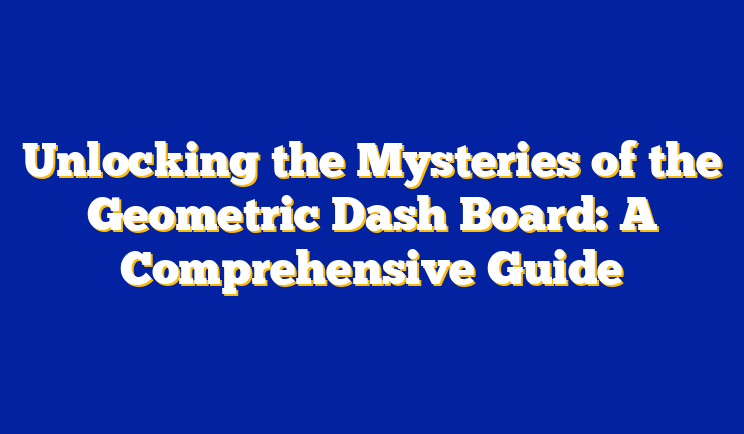In the realm of gaming, few titles have captured the imagination quite like Geometric Dash Board. This captivating game, known for its intricate levels and pulsating rhythms, has enthralled players worldwide. But what exactly lies beneath the surface of this geometric wonderland? Join us as we delve deep into the secrets of the Geometric Dash Board.
Download Geometry Dash APK from here.
Understanding Geometric Dash Board
At its core, Geometric Dash Board is a rhythm-based platformer game that tests players’ reflexes and coordination. The gameplay revolves around guiding a geometric shape through various obstacles and challenges, all synced to an electrifying soundtrack. From pulsating beats to adrenaline-pumping jumps, every moment in Geometric Dash Board is a thrill ride.
Mastering the Basics
To excel in Geometric Dash Board, mastering the basics is essential. The controls are simple yet precise, allowing players to navigate through each level with ease. With a combination of taps and swipes, you can maneuver your way through a maze of obstacles, all while staying in sync with the music. Practice makes perfect in Geometric Dash Board, so don’t be afraid to hone your skills in the early stages.
Exploring the Levels
One of the most intriguing aspects of Geometric Dash Board is its diverse range of levels. From neon-lit cityscapes to futuristic landscapes, each level offers a unique visual and auditory experience. As you progress through the game, you’ll encounter increasingly challenging obstacles and environments, keeping you on the edge of your seat at every turn.
Uncovering Secrets
Beneath the surface of Geometric Dash Board lies a treasure trove of secrets waiting to be discovered. Hidden pathways, elusive collectibles, and cryptic messages are scattered throughout the game, rewarding intrepid players with new insights and challenges. Keep your eyes peeled and your reflexes sharp as you uncover the mysteries of the Geometric Dash Board.
Community and Competition
While Geometric Dash Board can be enjoyed solo, its thriving community adds an extra layer of excitement to the experience. From online leaderboards to community-created levels, there’s no shortage of ways to connect with fellow players and test your skills. Whether you’re competing for the top spot or collaborating on new creations, the Geometric Dash Board community is always buzzing with activity.
Pushing the Limits
As you become more proficient in Geometric Dash Board, you may find yourself pushing the limits of what’s possible. Speedruns, challenges, and custom levels offer endless opportunities to test your skills and creativity. Whether you’re aiming for a perfect run or creating your own masterpiece, Geometric Dash Board provides the perfect canvas for self-expression and achievement.
Conclusion
In conclusion, Geometric Dash Board is more than just a game – it’s a journey into the heart of rhythm and geometry. With its captivating gameplay, diverse levels, and vibrant community, Geometric Dash Board offers an experience like no other. So, strap in, turn up the volume, and prepare to be dazzled by the wonders of the Geometric Dash Board.
FAQs
What is a Geometric Dashboard?
A geometric dashboard is a data visualization tool that presents information in a structured and visually intuitive manner using geometric shapes such as charts, graphs, and diagrams. It allows users to analyze complex datasets and identify patterns and trends with ease.
How Does a Geometric Dashboard Work?
Geometric dashboards work by collecting data from various sources, organizing it into visual components, and presenting it in a coherent and interactive format. Users can interact with the dashboard by selecting different parameters or filters to dynamically update the displayed information.
What are the Benefits of Using Geometric Dashboards?
Enhanced Data Understanding: Geometric dashboards provide a clear and concise representation of data, making it easier for users to understand complex relationships and trends.
Improved Decision Making: By visualizing data in a geometric format, decision-makers can quickly identify insights and make informed decisions.
Increased Efficiency: Geometric dashboards streamline the data analysis process, saving time and effort compared to manual methods.
Interactive Exploration: Users can interact with the dashboard to explore data from different perspectives and gain deeper insights.
How Can I Create a Geometric Dashboard?
Creating a geometric dashboard typically involves selecting a suitable data visualization tool such as Tableau, Power BI, or Google Data Studio. These tools offer a range of features and templates for building customized geometric dashboards tailored to specific data analysis requirements.
What are Some Common Geometric Dashboard Components?
Common components of geometric dashboards include:
Charts and Graphs: Line charts, bar graphs, pie charts, and scatter plots are commonly used to represent numerical data.
Maps: Geographic maps visualize spatial data and help identify geographical trends and patterns.
Tables: Tables provide a tabular representation of data and are useful for displaying detailed information.
Widgets: Interactive widgets such as sliders, dropdown menus, and buttons allow users to control dashboard parameters and filters.
How Can I Optimize the Performance of My Geometric Dashboard?
To optimize the performance of your geometric dashboard, consider the following tips:
Data Optimization: Ensure that your data is clean, organized, and properly formatted to prevent performance issues.
Dashboard Design: Keep the dashboard layout simple and intuitive, avoiding clutter and excessive visual elements.
Use of Filters: Implement filters and parameters to allow users to interact with the dashboard without overloading it with unnecessary data.
Regular Updates: Periodically review and update your dashboard to incorporate new data and insights.
How Can I Learn More About Geometric Dashboards?
To learn more about geometric dashboards, consider taking online courses, attending workshops, or exploring tutorials offered by data visualization platforms. Additionally, joining online communities and forums can provide valuable insights and tips from experienced users.

